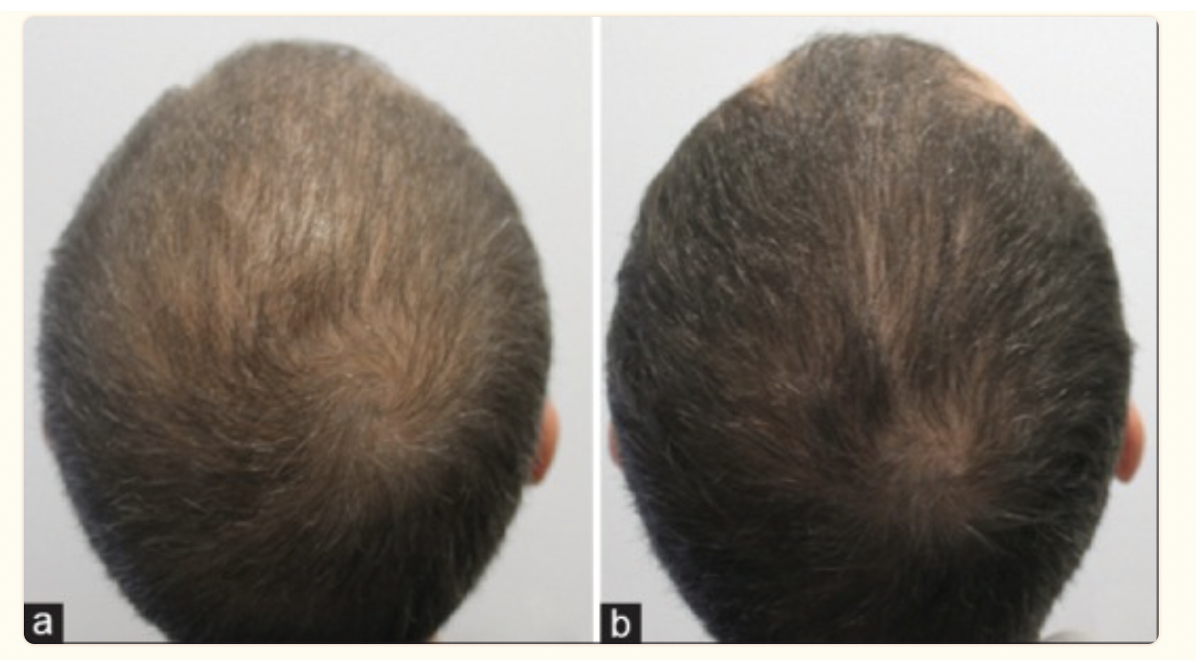Dutasteride Microneedling May Offer Options for Male Balding
Microneedling with 2.5 mm and 0.01 % Dutasteride Solution Promotes Hair Growth At 16 Weeks.
Prior studies have suggested a benefit of dutasteride mesotherapy with injection of dutasteride. This included a 2017 study by Saceda-Corralo and colleagues showing that dutasteride mesotherapy with 0.01 % dutasteride every 3 months produced an improvement in hair density without affecting serum hormone parameters.
A 2017 study by Saceda-Corralo and colleagues showed that dutasteride mesotherapy with 0.01 % dutasteride every 3 months produced an improvement in hair density without affecting serum hormone parameters. SOURCE: David Saceda-Corralo etal. Mesotherapy with Dutasteride in the Treatment of Androgenetic Alopecia. Int J Trichology. 2017 Jul-Sep; 9(3): 143–145. Used with creative commons license.
Sánchez-Meza et al. 2022
A new study from Mexico set out to determine the whether dutasteride solution applied to the scalp with microneedling would also offer benefits.
The authors performed a 20-week, randomized, double-blind, placebo-controlled study of microneedling plus topical 0.01% solution of dutasteride (MNSD) versus microneedling plus saline solution (MNSS) alone in males with androgenetic alopecia. Males age 18-65 with balding were randomly assigned to receive three sessions of MNSD or MNSS as monotherapy every four weeks. The authors then examined results at weeks 16 and 20.
The technique was described by the authors. They first applied a topical anaesthetic ointment of docaine/tetracaine for 45 minutes and then washed the area with an antiseptic solution. Microneedling was performed with a microneedling system (Dr. Pen model-ultima A6) which was adjusted to a level penetration of 2.5 mm. 1 mL of either 0.01 % Dutasteride (as Duta-ox) or 1 mL of saline was applied and patients were advised not to shampoo for 12 hours.
Three dermatologists compared baseline photographs and again at week 16 using a 4 point rating scale. Patients who had worse density were given a score of -1. Those patients with mild improvement were given a score of +1, and those with moderate and marked improvement were given scores of +2 and + 3, respectively. These were the primary endpoints. Patients who had more than 1 point difference in the Hamilton Norwood scale were said to have a marked improvement.
Secondary outcomes were changes in hair density, hair thickness, ration of terminal to vellus hairs, and quality of life.
Results
At week 16, a marked improvement was found in 52.9% of the men in the microneedling-dutasteride group (figure 1) and in 17.6% of those in the microneedling-saline group, with a statistical difference (p=0.037). There was a slight improvement in hair thickness, hair density at these times points in the microneedling-dutasteride group compared to the microneedling-saline group.
The procedure was well tolerated with redness and sensitivity lasting less than 36 hours. it was found in about 80 % of patients in both groups.
Conclusions
This small study showed that use of a commercially available 0.01 % dutasteride solution (Duta-ox) with 2.5 mm microneedling provided some degree of improvements at a 4-5 month times point compared to microneedling alone. The p values are just under 0.05 but nevertheless the data suggests this technique may benefit some males. More studies are needed with larger number of males and with dutasteride mesotherapy alone.
Side effects of mood changes and sexual dysfunction were not reported in this study nor was the study designed to evaluate changes in systemic hormone parameters.
This is a promising study that opens the doors for additional techniques for getting dutasteride into the scalp.
REFERENCES
Emmanuel Sánchez-Meza et al. Microneedling plus topical dutasteride solution for androgenetic alopecia: a randomized placebo-controlled study. J Eur Acad Dermatol Venereol. 2022 Jun 1. doi: 10.1111/jdv.18285.
David Saceda-Corralo etal. Mesotherapy with Dutasteride in the Treatment of Androgenetic Alopecia. Int J Trichology. 2017 Jul-Sep; 9(3): 143–145.
This article was written by Dr. Jeff Donovan, a Canadian and US board certified dermatologist specializing exclusively in hair loss.

